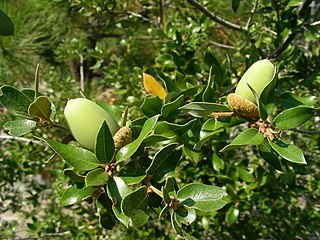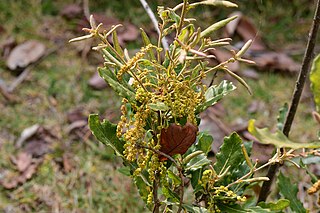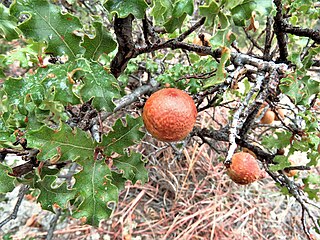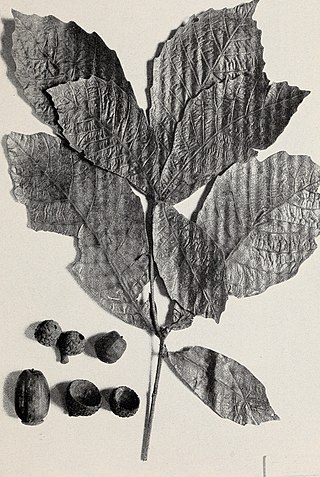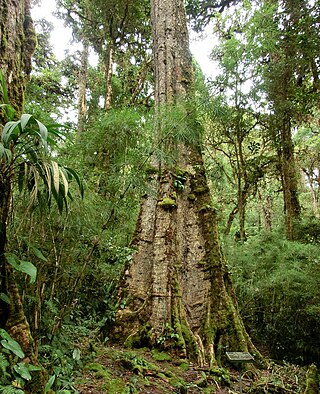Subgenus Quercus
Section Quercus
Section Mesobalanus was included in section Quercus in the 2017 classification used here. Other synonyms include Q. sect. Albae and Q. sect. Macrocarpae. The section comprises the white oaks from Europe, Asia, north Africa, Central and North America. [2] Styles short; acorns mature in 6 months, sweet or slightly bitter, inside of acorn shell hairless.[ citation needed ]
- Quercus aculcingensis Trel. – Mexico
- Quercus ajoensis C.H.Mull. – Ajo Mountain shrub oak, Blue shrub oak – Arizona, New Mexico, Baja California
- Quercus alba L. – white oak – eastern and central North America
- Quercus aliena Blume – Oriental white oak – eastern Asia
- Quercus alpescens Trel. – Mexico
- Quercus ariifolia Trel. – Mexico
- Quercus arizonica Sarg. – Arizona white oak – # southwestern U.S., northwestern Mexico
- Quercus austrina Small – bluff oak – southeastern North America
- Quercus × basaseachicensis C.H.Mull. – Mexico
- Quercus × bebbiana C.K.Schneid. — Bebb's oak — northeastern North America
- Quercus berberidifolia Liebm. – California scrub oak – # California
- Quercus bicolor Willd. – swamp white oak – eastern and midwestern North America
- Quercus × bimundorum E.J.Palmer — two worlds oak
- Quercus boyntonii Beadle – Boynton's post oak – south central North America
- Quercus canariensis Willd. – Mirbeck's oak or Algerian oak – # North Africa & Spain
- Quercus carmenensis C.H.Mull. – Carmen oak – Coahuila and Texas
- Quercus × cerrioides Willk. & Costa – east Spain
- Quercus chapmanii Sarg. – Chapman oak – # southeastern North America
- Quercus chartacea Trel. – Mexico
- Quercus chihuahuensis Trel. – Chihuahua oak – northern Mexico and Texas
- Quercus congesta C.Presl – Italy
- Quercus convallata Trel. – Mexico
- Quercus copeyensis C.H.Mull. – # Costa Rica, Panama
- Quercus cornelius-mulleri Nixon & K.P.Steele – Muller oak – # southwestern North America
- Quercus corrugata Hook. – Mexico, Central America
- Quercus dalechampii Ten. – southeastern Europe
- Quercus deliquescens C.H.Mull. – Mexico
- Quercus dentata Thunb. – daimyo oak – eastern Asia
- Quercus depressipes Trel. – Davis Mountain oak – northern Mexico and Texas
- Quercus deserticola Trel. – # Mexico
- Quercus diversifolia Née – Mexico
- Quercus douglasii Hook. & Arn. – blue oak – California
- Quercus dumosa Nutt. – coastal scrub oak – # southern California, Baja California, Arizona
- Quercus durata Jeps. – leather oak – # California
- Quercus edwardsiae C.H.Mull. – Mexico
- Quercus engelmannii Greene – Engelmann oak – # southern California, Baja California
- Quercus estremadurensis O.Schwarz – Portugal, Spain, Morocco
- Quercus fabrei Hance – Faber's oak – central to southern China
- Quercus faginea Lam. – Portuguese oak – # southwestern Europe
- Quercus frainetto Ten. — Hungarian oak — southeastern Europe
- Quercus frutex Trel. – Mexico
- † Quercus furuhjelmi — Eocene to Miocene - Alaska, Kazakhstan
- Quercus gambelii Nutt. – Gambel oak – southwestern North America
- Quercus garryana Douglas ex Hook. – Oregon white oak or Garry oak – western North America
- Quercus germana Schltdl. & Cham. – Mexico
- Quercus glabrescens Benth. – Mexico
- Quercus glaucescens Bonpl. – encino blanco – Mexico
- Quercus glaucoides M.Martens & Galeotti – # Mexico
- Quercus greggii (A.DC.) Trel. – # Mexico
- Quercus griffithii Hook.f. & Thomson ex Miq. – southeast Asia
- Quercus grisea Liebm. – gray oak – # southwestern North America
- Quercus hartwissiana Steven – Strandzha oak – southeastern Bulgaria, northern Turkey, western Georgia, southwestern Russia
- Quercus havardii Rydb. – Havard oak, shinnery oak, shin oak – south central North America
- † Quercus hiholensis — Miocene — # Washington State [4]
- Quercus hinckleyi C.H.Mull. – Hinckley oak – # Texas, northwestern Mexico
- Quercus infectoria G.Olivier – Aleppo oak, Cyprus oak – southern Europe, southwestern Asia
- Quercus insignis M.Martens & Galeotti – Mexico, Belize, Costa Rica, Guatemala, Panama
- Quercus intricata Trel. – Coahuila scrub oak – # two isolated localities in west Texas, northern Mexico
- Quercus invaginata Trel. – Mexico
- Quercus john-tuckeri Nixon & C.H.Mull. – Tucker's oak – California
- Quercus juergensenii Liebm. – Mexico
- Quercus kotschyana O.Schwarz – Lebanon
- Quercus laceyi Small – lacey oak – Edwards Plateau of Texas, northern Mexico
- Quercus laeta Liebm. – Mexico
- Quercus lancifolia Schltdl. & Cham. – southwestern North America, Mexico, South America
- Quercus liebmannii Oerst. ex Trel. — Mexico
- Quercus lobata Née – valley oak or California white oak – California
- Quercus lusitanica Lam. – gall oak or Lusitanian oak – Iberia, North Africa
- Quercus lyrata Walter – overcup oak – eastern North America
- Quercus × macdonaldii Greene & Kellogg – California
- Quercus macdougallii Martínez – Mexico
- Quercus macranthera Fisch. & C.A.Mey. ex Hohen. – Caucasian oak or Persian oak – western Asia
- Quercus macrocarpa Michx. – bur oak – eastern and central North America
- Quercus magnoliifolia Née – Mexico
- Quercus manzanillana Trel. – Mexico
- Quercus margarettae (also Q. margaretiae and Q. margarettiae) — sand post oak — southeastern North America
- Quercus martinezii C.H.Mull. – # Mexico
- Quercus michauxii Nutt. – swamp chestnut oak – eastern North America
- Quercus microphylla Née – Mexico
- Quercus mohriana Buckley ex Rydb. – Mohr oak – # southwestern North America
- Quercus mongolica Fisch. ex Ledeb. – Mongolian oak – eastern Asia
- Quercus monnula Y.C.Hsu & H.Wei Jen – south-central China
- Quercus montana Willd. – chestnut oak – eastern North America (= Quercus prinus)
- Quercus muehlenbergii Engelm. – Chinkapin oak – eastern, central, and southwestern US (West Texas and New Mexico), northern Mexico
- Quercus ningqiangensis S.Z.Qu & W.H.Zhang – southeastern China
- Quercus oblongifolia Torr. – Arizona blue oak, Southwestern blue oak, or Mexican blue oak – # southwestern U.S., northwestern Mexico
- Quercus obtusata Bonpl. – Mexico
- Quercus oglethorpensis W.H.Duncan – Oglethorpe oak – southeastern North America
- Quercus oocarpa Liebm. – Mexico
- Quercus opaca Trel. – Mexico
- Quercus pacifica Nixon & C.H.Mull. – # Channel Islands, California
- Quercus peduncularis Née – # Central America
- Quercus perpallida Trel. – Mexico
- Quercus petraea (Matt.) Liebl. – sessile oak, durmast oak – Europe, Anatolia
- Quercus polymorpha Schltdl. & Cham. – Monterrey oak, Mexican white oak – # Mexico and extreme S. Texas
- Quercus porphyrogenita Trel. – Mexico
- Quercus potosina Trel. – Mexico
- Quercus praeco Trel. – Mexico
- Quercus pringlei Seemen ex Loes. – Mexico
- Quercus prinoides Willd. – dwarf chinkapin oak – eastern North America
- Quercus pubescens Willd. – downy oak or Italian oak – Europe, Anatolia
- Quercus pungens Liebm. – sandpaper oak or pungens oak – southwestern U.S., Mexico
- Quercus purulhana Trel. – Mexico, Central America
- Quercus pyrenaica Willd. – Pyrenean oak – southwestern Europe
- Quercus rekonis Trel. – Mexico
- Quercus repanda Bonpl. – Mexico
- Quercus resinosa Liebm. – Mexico
- Quercus robur L. – pedunculate oak, English oak or French oak – Europe, West Asia
- Quercus rugosa Née – netleaf oak or Rugosa oak – # southwestern U.S., northwestern Mexico
- Quercus × schuettei Trel. — Schuette's oak — US, Canada
- Quercus sebifera Trel. – # Mexico
- Quercus segoviensis Liebm. – Mexico and northern Central America
- Quercus serrata Murray – bao li – # China, Taiwan, Japan, Korea
- Quercus shennongii C.C.Huang & S.H.Fu – southeastern China
- Quercus shingjenensis Y.T.Chang – China (Guizhou)
- Quercus similis Ashe – swamp post oak – southeastern North America
- Quercus sinuata Walter – bastard oak – southern US (formerly identified as Quercus durandii)
- Quercus sororia Liebm. – Mexico
- Quercus stellata Wangenh. – post oak – eastern North America
- Quercus striatula Trel. – Mexico (Sierra Madre Occidental and Mexican Plateau ranges)
- Quercus subspathulata Trel. – Mexico
- Quercus supranitida C.H.Mull. – Mexico
- Quercus tinkhamii C.H.Mull. — Mexico
- Quercus toumeyi Sarg. — Toumey oak — # southwest New Mexico, southeastern Arizona, northern Mexico
- Quercus tuberculata Liebm. — Mexico
- Quercus turbinella Greene — turbinella oak, Arizona Blue Shrub oak, Shrub live oak or scrub live oak — # southwestern North America
- Quercus vaseyana Buckley — Vasey oak — # southwestern North America
- Quercus verde C.H.Mull. — Mexico
- Quercus vicentensis Trel. — El Salvador, Guatemala, and southern Mexico
- Quercus vulcanica Boiss. & Heldr. ex Kotschy — Kasnak oak — southwestern Asia
- Quercus welshii R.A.Denham — havard oak, Utah sand oak, wavy leaf oak — # southwestern North America
- Quercus wutaishanica Mayr — Liaoning oak — China, Mongolia
- Quercus xylina Scheidw. — Mexico [5]

Section Ponticae
Species are native to Western Asia and Western North America. They produce catkins up to 10cm long; the acorns mature annually. [2]
- Quercus pontica — Pontine oak — western Asia
- Quercus sadleriana — deer oak — # southwestern Oregon, northern California
Section Protobalanus
The intermediate oaks. Southwest USA and northwest Mexico. Styles short, acorns mature in 18 months, very bitter, inside of acorn shell woolly.[ citation needed ]
- Quercus cedrosensis — Cedros Island oak — # California + Baja California
- Quercus chrysolepis — canyon live oak — # southwestern North America
- Quercus palmeri — Palmer oak — # California, western Arizona
- Quercus tomentella — island oak — # offshore islands of California + Baja California
- Quercus vacciniifolia — huckleberry oak — # southwestern North America
Section Lobatae
The red oaks (synonym sect. Erythrobalanus), native to North, Central and South America. [2] Styles long, acorns mature in 18 months (in most species), [6] very bitter, inside of acorn shell woolly.[ citation needed ]
- Quercus acatenangensis Trel. – Mexico, Guatemala, El Salvador
- Quercus acerifolia (E.J.Palmer) Stoynoff & W.J.Hess ex R.J.Jensen – maple-leaved oak or mapleleaf oak – Arkansas
- Quercus acherdophylla Trel. – # Mexico
- Quercus acutangula Trel. – Mexico
- Quercus acutifolia , syn. Quercus conspersa — Mexico
- Quercus aerea Trel. — Mexico
- Quercus affinis Scheidw. – # Mexico
- Quercus agrifolia Née – coast live oak – # California, northern Baja California
- Quercus albocincta Trel. – Mexico (Sierra Madre Occidental)
- Quercus aristata Hook. & Arn. – Mexico
- Quercus arkansana Sarg. – Arkansas oak – southeastern North America
- Quercus benthamii A.DC. – # southern Mexico and Central America
- Quercus brenesii Trel. – Costa Rica, Mexico
- Quercus buckleyi Nixon & Dorr – Texas red oak – south central North America
- Quercus calophylla Schltdl. & Cham. — Mexico
- Quercus canbyi Trel. (syn. Quercus graciliformis) – Canby oak or Mexican red oak – # Texas, Mexico
- Quercus castanea Née – # Mexico
- Quercus charcasana Trel. ex A.Camus – Mexico
- Quercus chimaltenangana Trel. – Guatemala
- Quercus coahuilensis Nixon & C.H.Mull. – Mexico
- Quercus coccinea Münchh. – scarlet oak – eastern North America
- Quercus coffeicolor Trel. – Mexico
- Quercus confertifolia Bonpl. (syn. Quercus gentryi) — Mexico
- Quercus conzattii Trel. – Mexico
- Quercus cortesii Liebm. – # southern Mexico and Central America
- Quercus costaricensis Liebm. – # Costa Rica, Panama
- Quercus crassifolia Bonpl. – Mexico
- Quercus crassipes Bonpl. – Mexico
- Quercus crispifolia Trel. — Mexico
- Quercus crispipilis Trel. – Mexico, Guatemala
- Quercus cualensis L.M.González – # Mexico (Sierra Madre del Sur)
- Quercus delgadoana S.Valencia, Nixon & L.M.Kelly – Mexico
- Quercus depressa Bonpl. – Mexico
- Quercus devia Goldman – Mexico (Baja California Peninsula)
- Quercus durifolia Seemen ex Loes. – Mexico (Sierra Madre Occidental)
- Quercus × dysophylla — Mexico
- Quercus eduardi Trel. — Mexico
- Quercus ellipsoidalis E.J.Hill – northern pin oak – eastern North America
- Quercus elliptica Née – Mexico
- Quercus emoryi Torr. – Emory oak – # southwestern U.S., northern Mexico
- Quercus falcata Michx. – southern red oak or Spanish oak – southeastern North America
- Quercus floccosa Liebm. – Mexico
- Quercus flocculenta C.H.Mull. — Mexico
- Quercus fulva Liebm. – Mexico
- Quercus furfuracea Liebm. – Mexico
- Quercus galeanensis C.H.Mull. – Mexico
- Quercus georgiana M.A.Curtis – Georgia oak – southeastern North America
- Quercus gracilior C.H.Mull. – Honduras
- Quercus grahamii Benth. – Mexico
- Quercus gravesii Sudw. – Chisos red oak or Graves oak – Mexico, southwestern North America (Texas)
- Quercus gulielmi-treleasei C.H.Mull. – Costa Rica to western Panama
- Quercus hemisphaerica W.Bartram ex Willd. – laurel oak or Darlington oak – # southeastern North America
- Quercus hintonii E.F.Warb. – Mexico
- Quercus hintoniorum Nixon & C.H.Mull. – # Mexico
- Quercus hirtifolia M.L.Vázquez, S.Valencia & Nixon – # Mexico
- Quercus humboldtii Bonpl. – Andean oak – # northern South America (Colombia & Panama)
- Quercus hypoleucoides A.Camus – silverleaf oak – # southwestern North America
- Quercus hypoxantha Trel. – # Mexico
- Quercus ignaciensis C.H.Mull. – Sonora
- Quercus ilicifolia Wangenh. – bear oak – eastern North America
- Quercus iltisii L.M.González – western Mexico
- Quercus imbricaria Michx. – shingle oak – eastern North America
- Quercus incana W.Bartram – bluejack oak – southeastern North America
- Quercus inopina Ashe – sandhill oak – Florida
- Quercus jonesii Trel. – northern Mexico
- Quercus kelloggii Newb. – California black oak – California, southwestern Oregon
- Quercus laevis Walter – turkey oak – southeastern North America
- Quercus laurifolia Michx. – laurel oak – # southeastern North America
- Quercus laurina Bonpl. – # Mexico
- Quercus marilandica (L.) Münchh. – blackjack oak – eastern North America
- Quercus mcvaughii Spellenb. (orth. var. Q. macvaughii) — Mexico (northern and central Sierra Madre Occidental)
- Quercus mexicana Bonpl. – Mexico
- Quercus miquihuanensis Nixon & C.H.Mull. – Mexico (Sierra Madre Oriental)
- Quercus mulleri Martínez – Mexico
- Quercus myrtifolia Willd. – myrtle oak – # southeastern North America
- Quercus nigra L. – water oak – # eastern North America
- Quercus nixoniana S.Valencia & Lozada-Pérez – Mexico
- Quercus pagoda Raf. – cherrybark oak – southeastern North America
- Quercus palustris Münchh. – pin oak – eastern North America
- Quercus panamandinaea C.H.Mull. – Panama
- Quercus parvula Greene – Shreve oak, Santa Cruz Island oak – # coastal California
- Quercus paxtalensis C.H.Mull. – Mexico
- Quercus peninsularis Trel. – Mexico (Baja California)
- Quercus pennivenia Trel. – Mexico
- Quercus phellos L. – willow oak – eastern North America
- Quercus pinnativenulosa C.H.Mull. – Mexico
- Quercus planipocula Trel. – western Mexico
- Quercus pumila Walter – runner oak – # southeastern North America
- Quercus radiata Trel. – Mexico (southern Sierra Madre Occidental)
- Quercus robusta C.H.Mull. – Chisos Mountains of Texas
- Quercus rubra L. – northern red oak – eastern North America
- Quercus rubramenta Trel. – Mexico
- Quercus runcinatifolia Trel. & C.H.Mull. – Mexico
- Quercus rysophylla Weath. – loquat-leaf oak – # Mexico
- Quercus salicifolia Née – # Mexico
- Quercus saltillensis Trel. — Mexico
- Quercus sapotifolia Liebm. – # southern Mexico, Central America
- Quercus sartorii Liebm. – Mexico
- Quercus scytophylla Liebm. — Mexico
- Quercus seemannii Liebm. – southeastern Mexico and Central America
- Quercus shumardii Buckley – Shumard oak – eastern North America
- Quercus sideroxyla Bonpl. – Mexico
- Quercus skinneri Benth. – Mexico (Chiapas, Oaxaca, Tamaulipas, Veracruz) Guatemala, El Salvador, Honduras
- Quercus tarahumara Spellenb., J.D.Bacon & Breedlove – Mexico
- Quercus tardifolia C.H.Mull. – lateleaf oak – # two small clumps in Chisos Mountains of Texas
- Quercus texana Buckley – Nuttall's oak – south central North America (Lower Mississippi River Valley)
- Quercus tonduzii Seemen – Costa Rica
- Quercus tuitensis L.M.González — Mexico
- Quercus urbani Trel. – Mexico
- Quercus uxoris McVaugh – Mexico
- Quercus velutina Lam. – black oak or eastern black oak or dyer's oak – eastern North America
- Quercus viminea Trel. – # Mexico
- Quercus wislizeni A.DC. – interior live oak – # California
- Quercus xalapensis Bonpl. – Mexico, Central America
Section Virentes
Section Virentes has also been treated at lower ranks. Species are native south-eastern Northern America, Mexico, the West Indies (Cuba), and Central America. [2] A 2017 classification included seven species: [3]
- Quercus brandegeei Goldman – Brandegee oak- Baja California Sur
- Quercus fusiformis Small – Texas live oak or plateau live oak – # south central North America
- Quercus geminata Small – sand live oak – # southeastern United States
- Quercus minima (Sarg.) Small – dwarf live oak – # southeastern North America
- Quercus oleoides Schltdl. & Cham. – # from Costa Rica into Mexico
- Quercus sagrana (also spelt Q. sagraeana) – Cuban oak – # western Cuba
- Quercus virginiana Mill. – southern live oak – # southeastern North America




